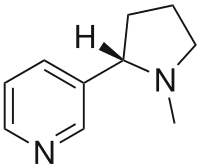
Photo from wikipedia
Despite the reduced life expectancy and staggering financial burden of medical treatment associated with tobacco smoking, the molecular, cellular, and ensemble adaptations associated with chronic nicotine consumption remain poorly understood.… Click to show full abstract
Despite the reduced life expectancy and staggering financial burden of medical treatment associated with tobacco smoking, the molecular, cellular, and ensemble adaptations associated with chronic nicotine consumption remain poorly understood. Complex circuitry interconnecting dopaminergic and cholinergic regions of the midbrain and mesopontine tegmentum are critical for nicotine associated reward. Yet our knowledge of the nicotine activation of these regions is incomplete, in part due to their cell type diversity. We performed double immunohistochemistry for the immediate early gene and surrogate activity sensor, c‐Fos, and markers for either cholinergic, dopaminergic or GABAergic cell types in mice treated with nicotine. Both acute (0.5 mg/kg) and chronic (0.5 mg/kg/day for 7 days) nicotine strongly activated GABAergic neurons of the interpeduncular nucleus and medial terminal nucleus of the accessory optic tract (MT). Acute but not chronic nicotine also activated small percentages of dopaminergic and other neurons in the ventral tegmental area (VTA) as well as noncholinergic neurons in the pedunculotegmental and laterodorsal tegmental nuclei (PTg/LDTg). Twenty four hours of nicotine withdrawal after chronic nicotine treatment suppressed c‐Fos activation in the MT. In comparison to nicotine, a single dose of cocaine caused a similar activation in the PTg/LDTg but not the VTA where GABAergic cells were strongly activated but dopaminergic neurons were not affected. These results indicate the existence of drug of abuse specific ensembles. The loss of ensemble activation in the VTA and PTg/LDTg after chronic nicotine represents a molecular and cellular tolerance which may have implications for the mechanisms underlying nicotine dependence.
Journal Title: Journal of Comparative Neurology
Year Published: 2018
Link to full text (if available)
Share on Social Media: Sign Up to like & get
recommendations!